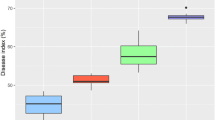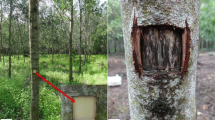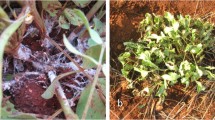Abstract
Fifty-three cassava lines were selected from breeding populations at the International Institute of Tropical Agriculture (IITA), Ibadan, Nigeria and screened in vitro for resistance to cassava anthracnose disease (CAD). The in vitro inoculation of stem cuttings with the fungus Colletotrichum gloeosporioides f.sp. manihotis showed significant differences (p ± 0.05) in acervuli production and in the sensitivity of the cassava lines to the fungal infection after 7 days of incubation at 25 °C. Cassava lines 88/01084, 91/00595, 91/00475, 91/00344, 91/00684, 91/00313, 91/00422, and 91/00344 were highly resistant, with necrotic lesion sizes less than 7 mm. In contrast pedigree lines 88/02549, 89/0008, 91/00390 and 91/00402 were highly susceptible with the largest necrotic lesion size being greater than 20 mm. Ten cassava lines from the in vitro screening that showed varying levels of resistance to CAD were selected, based on their flowering abilities for diallel hydridization trials, and were further screened in greenhouse and field trials for CAD resistance. The greenhouse and field screening showed significant varietal differences (p ± 0.05) in sensitivity to the fungus. In all cases, the progeny lines showed correlated levels of resistance irrespective of the type of screening or assessments. Correlation analysis of the in vitro, greenhouse and field assessments showed that there was a good correspondence among all three methods of evaluating for CAD.
Similar content being viewed by others
References
Ahouandjinou NK. In vitro and in vivo studies in screening methods for resistance to cassava anthracnose disease. Thèse pour l'obtention du diplome d'ingenieur agronomie, Universite Nat. Benin et Univ, Ibadan, Nigeria, 1983: 64pp.
Asiedu R, Bai KV, Terauchi R, Dixon AGO, Hahn SK. Biotechnology: enhancing research on tropical crops in Africa. In: Thottapilly, G, Monti LM, Moore AW, eds., IITA/CTA Publication, 1992: 63–68.
Barnett HI and Hunter BB. Illustrated genera of imperfect fungi, 3rd edn. Burgess Publishing Company, 1971: 209pp.
Fokunang CN, Ikotun T, Dixon AGO. Mycelial growth, sporulation and spore germination of virulent Colletotrichum gloeosporioides f.sp. manihotis isolates under selected growth conditions. African J Root and Tuber Crops 1995; 1: 26–31.
Fokunang CN, Akem CN, Ikotun T, Dixon AGO. Effect of planting season on cassava anthracnose disease development. Crop Protection 1999a; 18: 407–413
Fokunang CN, Akem CN, Ikotun T, Dixon AGO, Tembe EA. Seed survival and transmission of cassava anthracnose disease, and seed treatment effect on seedling growth. Pakistan J Biol Sci 1999b; 2(3): 849–854.
Fokunang CN, Akem CN, Ikotun T, Dixon AGO, Tembe EA. Role of the insect vector, Pseudotheraptus devastans, in cassava anthracnose disease development. Eur J Plant Pathol 2000a; 106(4): 319–327.
Fokunang CN, Akem CN, Ikotun T, Dixon AGO. Germplasm evaluation of cassava genotypes for resistance to anthracnose, bacterial blight and mosaic diseases, and their effects on yield. Genet Resours Crop Evol 2000b; 47: 63–71.
Fokunang CN, Ikotun T, Akem CN, Dixon AGO, Tembe EA, Koona P. Investigation of inoculum threshold and latent infection in Colletotrichum gloeosporioides f.sp. manihotis, in cassava cultivars. Pakistan J Biol Sci 2000c; 3: 713–716.
Friend J. Plant phenolics, lignification in disease resistance. Pytochemistry 1981; 7: 197–261.
Goodman RN, Novasky AJ. The hypersensitivity reaction in plant pathogens: A resistance phenomenon. St. Paul, MN: APS Press, 1994: 3–35.
Hahn SK, Ikotun T, Theberge RL, Swennen R. Major economic diseases of cassava, Plantain and cooking starchy Bananas in Africa. Trop Agric Res Series 1989; No. 22: 5pp.
International Institute of Tropical Agriculture (IITA) Cassava in Tropical Africa. A Reference Manual. IITA, Ibadan, Nigeria, 1990: 108pp.
Ikotun T, Hahn SK. Screening cassava cultivars for resistance to cassava anthracnose disease. In: Ofori F, Hahn SK, eds. Proceedings of the Ninth Symposium of the International Society of Tropical Root Crops (ISTRC), held in Accra, Ghana, 20–26 October 1991. 1994: 178–183.
Lozano JC, Booth RH. Diseases of Cassava (Manihot esculenta Crantz). Pest Article and Summary. PANS 1974; 20: 30–54.
Goodman, RN, Novasky, AJ. The Hypersensitive reaction in plant pathogens: a resistant phenomenon. St. Paul, MN: APS Press, 1994: 3–35.
Muimba KA. Predisposition of cassava plants to infection by Colletotrichum gloeosporioides f.sp manihotis. Henn, and some factors involved in the initiation of anthracnose disease. M.Phil. thesis. Dept. of Agric. Biology, University of Ibadan, Nigeria, 1982: 235pp.
Theberge RL. Common African pests and diseases of cassava, yam, sweet potato and cocoyam. IITA, Ibadan, Nigeria 1985: 107pp.
SAS Institute. SAS users guide: Statistic, Version 5. Cary, NC: SAS Incorporated, 1989: 235pp.
Van der Bruggen P, Maraite H. Histopathology of cassava anthracnose disease caused by Colletotrichum gloeosporioides f.sp. manihotis. Parasitica 1987; 43(1): 3–21.
Van der Bruggen P, Gregoire PD, Maraite H. Temperature induced alteration in the expression of susceptibility of cassava to Colletotrichum gloeosporioides f.sp. manihotis. J Phytopathol 1990; 130: 46–58.
Author information
Authors and Affiliations
Rights and permissions
About this article
Cite this article
Fokunang, C., Dixon, A., Ikotun, T. et al. In vitro, greenhouse and field assessments of cassava lines for resistance to anthracnose disease caused by Colletotrichum gloeosporioides f.sp. manihotis . Mycopathologia 154, 191–198 (2002). https://doi.org/10.1023/A:1016372208982
Issue Date:
DOI: https://doi.org/10.1023/A:1016372208982




